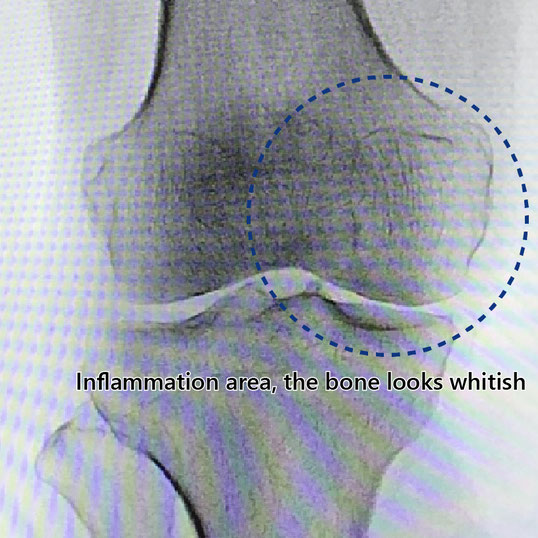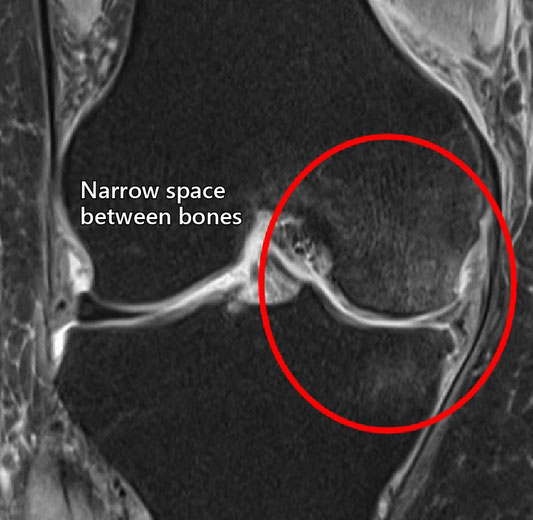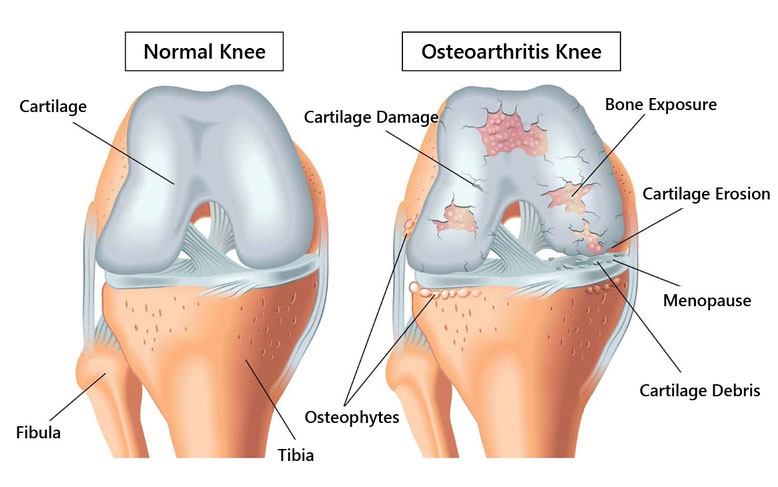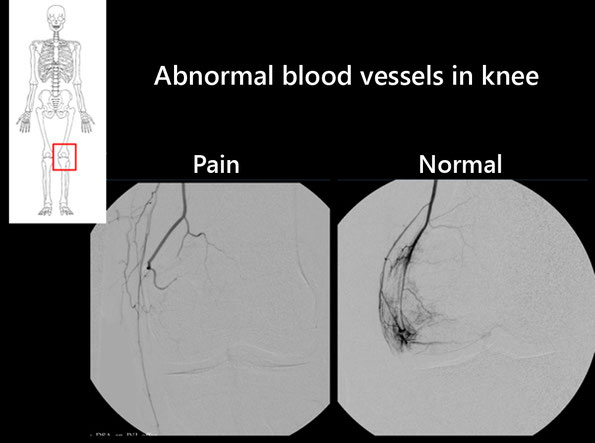-
My knee hurts and when I went to the hospital for taking X-ray, I was told that the gap between the bones was narrow.
-
It may be a condition called knee osteoarthritis.
It is normal for joints to have cartilage between bones. The cartilage prevents the bones from colliding with each other. However, as we age and inflammation occurs in the joints, the cartilage wears away. This puts strains on the bones, and they lose their original shape and become deformed into a bumpy and uneven shape, which is called osteoarthritis.


Treatment methods vary depending on the degree of deformity. If the condition is in its early stages, it may be possible to prevent from progressing. If you recognize any of the symptoms, it is recommended to visit one of specialized medical institutions.
-
What are the symptoms of osteoarthritis of the knee?
-
Typical symptoms include painful inability to sit upright, feeling pain when going down the stairs or standing up from chair. If the inflammation is strong, the pain may sting or throb even when you are sleeping at night. In the case of severe bone deformity, the bones collide with each other and become painful when walking.
It can be prevented in the early stages, so if your knee pain persists for a long time, it is better to visit a specialized medical institution.
-
I went to the hospital and was told that the X-rays did not look so bad, but my knee is very painful. What is going on my knee?
-
The deformity of the bone on x-ray examination does not always coincide with the intensity of the pain. In other words, some people have strong pain even though the x-rays don’t show much deformity, but some people have no pain even though the x-rays show the deformity.
In fact, the pain of osteoarthritis of the knee is not only caused by bone deformity. Bone deformity can cause pain when the deformity is quite severe, but it is not the cause of pain at the stage before it becomes severe. Then, what can cause of pain except the bone deformation?
One of the causes is inflammation. Inflammation around the knee joint can cause pain. It has also recently been discovered that many abnormal blood vessels can form around the joint, and they cause pain.
You can also check the article here for the study.

-
I was diagnosed with Knee Osteoarthritis. Is there any prevention to stop progressing the deformation?
-
Yes, there is.
There are some causes of knee osteoarthritis. One of them is weight. It is easier to understand, the heavier the weight, the more strain on knee and the more cartilage is worn out.Weight is not only one cause. In fact, it is known that taking a high-calorie food itself can cause inflammation in the body (even your weight is not so heavy), and that inflammation can lead to increased pain and deformity. Basically, the human body is prone to inflammation when it takes in too many calories from carbohydrates and fats. And when inflammation occurs, a substance called "inflammatory cytokines" is released. The name sounds complicated, but please understand that it is a substance that damages the body's tissues.
When inflammation occurs in the knee, the cartilage in the knee is damaged by inflammatory cytokines and wears out. Therefore, it is important to avoid inflammation.
It is also important to promptly reduce inflammation if it has already occurred. Inflammation causes pain in the knee, so pain indicates inflammation is occurring. Treatment to reduce inflammation can improve pain and prevent further progression of deformity in the future.
Another preventive treatment is 15-second acupressure. How to do this is discussed in detail in the "Self-Prevention" section below.
-
My knee pain is more intense on bad weather days. Why is this? Why?
-
Many people whose knee pain changes with the weather condition, especially the pain increases before it rains.
As I answered in the question above, it is not only the bones relating to causing osteoarthritis pain. Blood vessels are also important.
As shown in the figure below, osteoarthritis of the knee causes an increase in abnormal blood vessels in the painful area. When blood vessels increase, nerve fibers tend to increase with them, so where there is an increase in these blood vessels, there is also an increase in nerves, and the increased blood flow causes throbbing pain.

Now, especially on rainy days, the atmospheric pressure drops. Since human blood vessels tend to dilate with a drop in air pressure, blood flow to abnormal blood vessels also increases, leading to increased pain.
If your pain changes with the weather, it may be caused by blood vessels. We urge you to see a medical specialist.
-
I have osteoarthritis of the knee. Is there anything I can do to help myself cope with it? (Self-Prevention)
-
One simplified method that you can do by yourself is 15-second acupressure.
With the knee osteoarthritis, there are "pressure points" around the knee. Often there is one or more small areas about the size of one finger. Obviously, this is a point that hurts more than other places. If you feel pain on the inside of your knee, you can press inward; if you have pain on the outside, you can press outward; and if you press various places around your knee with your thumb, you should be able to discover the point.
If you can find this painful point, keep pressing there for 15 seconds. It does not have to be so strong. You will feel pain when you start pressing, but if you keep pressing, you will notice that the pain goes away.
-
I was recommended surgery for knee osteoarthritis. What kind of surgery is available?
-
There are three types of surgery: arthroscopic surgery, high tibial osteotomy, and artificial knee joint replacement.
Arthroscopic surgery is a procedure in which four holes are drilled in the knee and a thin scope, called an arthroscope, is used to observe the inside of the knee joint to clean out synovial membrane, joint rats, and other potential sources of pain. In the early stages, some patients may be relieved of pain, but since the deformity of the joint remains the same, the pain may recur over time.
High tibial osteotomy is a surgery to correct bowlegs by cutting a portion of the tibia (shin bone). It requires the implantation of an artificial bone and fixation with a metal plate, which increases the length of hospital stay. This surgery is often performed recently on patients who are relatively active.
Artificial knee joint replacement is performed for patient with severe deformity. It is a surgery to replace one's own deformed joint with a metal implant joint. Patients with end-stage deformity are eligible for this surgery. However, a certain percentage of patients remain in pain even after the surgery.
If your doctor recommends surgery, ask him or her in detail about the progression of your knee deformity, which surgery is suitable for you, what your postoperative life will be like, and the probability that you may still have pain.
-
I have osteoarthritis of the knee and am wondering if I should have surgery. Is there any non-surgical way to improve it?
-
Surgery for knee arthroplasty or osteotomy is a very heavy burden on the body and should certainly be chosen carefully. As a non-surgical option, "multidisciplinary treatment," which combines various therapies, is effective.
Multidisciplinary treatment means combining several "non-surgical methods" to relieve knee pain.
For example, as described on this site, catheterization to reduce the number of abnormal blood vessels around the knee (for more information, see this page https://okuno-y-clinic.com/en/problem-blood-vessels/ ), adding embolic agent to strengthen the bones if there is bone damage, reviewing lifestyle to produce more serotonin, and/or losing weight by actively managing diet. This is a treatment to relieve pain without surgery as much as possible.
If you are interested in multidisciplinary treatment, please consult with a medical facility specializing in pain management.